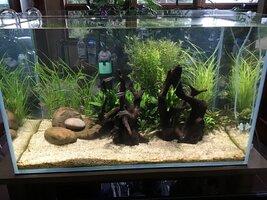Hi UKAPS: I’m looking for some aquascaping advice. I’m new to the hobby and I’m trying to strike the right balance between a verdant aquascape that requires higher maintenance and only lasting a short while versus a more biotopic setup with lower maintenance that lasts a long time.
I like this African Cichlid set up show here on the Tropica website - Layout 21 - Tropica Aquarium Plants
What I like about this layout:
Mike
I like this African Cichlid set up show here on the Tropica website - Layout 21 - Tropica Aquarium Plants
What I like about this layout:
- You can easily see the fish
- I like the rocks and sand substrate
- I like the two types of plants used
- There are too few plants (both amount and type)
- The plants don’t look healthy – maybe lack of CO2
The general recommendation is to use high nutrient soil and plant like crazy so algae doesn’t get the upper hand. I would rather use the proper amount of soil and use the matching amount of plants. Vallisneria spiralis and Cryptocoryne willisii (plus whatever else I choose) are substrate feeders and need soil (from what I understand). The question is, how do you prevent soil, sand and gravel from mixing?
Building the substrate - Aquascaping Wiki
Aquasabi recommends mesh fabric and PET foil to keep different substrates separate.
- Has anyone used this isolation scheme in a long term set up and would recommend it or is it just for a short term aquascape?
- If the soil is depleted of nutrients in a year or so and you need to add fertilizer capsules beyond that, should I just start with the gravel and capsule approach in the beginning and skip the soil layer all together?
- I did a search on UKAPS regarding this question of soil and sand. One person reported that Green Aqua said this could be done providing the soil layer was thin and the sand layer was thick. Subsequently, I watched a Green Aqua Q&A and Tommy said don’t use layers of sand and soil because they always intermingle.
Lost in Oregon,Mike



